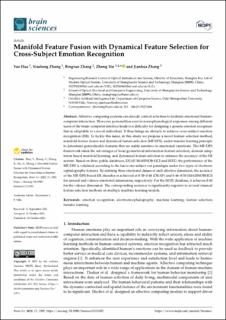| dc.contributor.author | Hua, Yue | |
| dc.contributor.author | Zhong, Xiaolong | |
| dc.contributor.author | Zhang, Bingxue | |
| dc.contributor.author | Yin, Zhong | |
| dc.contributor.author | Zhang, Jianhua | |
| dc.date.accessioned | 2022-04-19T08:55:39Z | |
| dc.date.available | 2022-04-19T08:55:39Z | |
| dc.date.created | 2021-12-03T14:22:28Z | |
| dc.date.issued | 2021-10-23 | |
| dc.identifier.citation | Brain Sciences. 2021, 11 (11), . | en_US |
| dc.identifier.issn | 2076-3425 | |
| dc.identifier.uri | https://hdl.handle.net/11250/2991253 | |
| dc.description.abstract | Affective computing systems can decode cortical activities to facilitate emotional human– computer interaction. However, personalities exist in neurophysiological responses among different users of the brain–computer interface leads to a difficulty for designing a generic emotion recognizer that is adaptable to a novel individual. It thus brings an obstacle to achieve cross-subject emotion recognition (ER). To tackle this issue, in this study we propose a novel feature selection method, manifold feature fusion and dynamical feature selection (MF-DFS), under transfer learning principle to determine generalizable features that are stably sensitive to emotional variations. The MF-DFS framework takes the advantages of local geometrical information feature selection, domain adaptation based manifold learning, and dynamical feature selection to enhance the accuracy of the ER system. Based on three public databases, DEAP, MAHNOB-HCI and SEED, the performance of the MF-DFS is validated according to the leave-one-subject-out paradigm under two types of electroencephalography features. By defining three emotional classes of each affective dimension, the accuracy of the MF-DFS-based ER classifier is achieved at 0.50–0.48 (DEAP) and 0.46–0.50 (MAHNOBHCI) for arousal and valence emotional dimensions, respectively. For the SEED database, it achieves 0.40 for the valence dimension. The corresponding accuracy is significantly superior to several classical feature selection methods on multiple machine learning models. | en_US |
| dc.description.sponsorship | This work is sponsored by the National Natural Science Foundation of China under Grant No. 61703277 and the Shanghai Sailing Program under Grant No. 17YF1427000. | en_US |
| dc.language.iso | eng | en_US |
| dc.publisher | MDPI | en_US |
| dc.relation.ispartofseries | Brain Sciences;Volume 11 / Issue 11 | |
| dc.rights | Navngivelse 4.0 Internasjonal | * |
| dc.rights.uri | http://creativecommons.org/licenses/by/4.0/deed.no | * |
| dc.subject | Emotion recognition | en_US |
| dc.subject | Electroencephalography | en_US |
| dc.subject | Machine learning | en_US |
| dc.subject | Feature selection | en_US |
| dc.subject | Transfer learning | en_US |
| dc.title | Manifold feature fusion with dynamical feature selection for cross-subject emotion recognition | en_US |
| dc.type | Peer reviewed | en_US |
| dc.type | Journal article | en_US |
| dc.description.version | publishedVersion | en_US |
| dc.rights.holder | © 2021 by the authors. | en_US |
| cristin.ispublished | true | |
| cristin.fulltext | original | |
| cristin.qualitycode | 1 | |
| dc.identifier.doi | https://doi.org/10.3390/brainsci11111392 | |
| dc.identifier.cristin | 1964432 | |
| dc.source.journal | Brain Sciences | en_US |
| dc.source.volume | 11 | en_US |
| dc.source.issue | 11 | en_US |
| dc.source.pagenumber | 1-24 | en_US |

